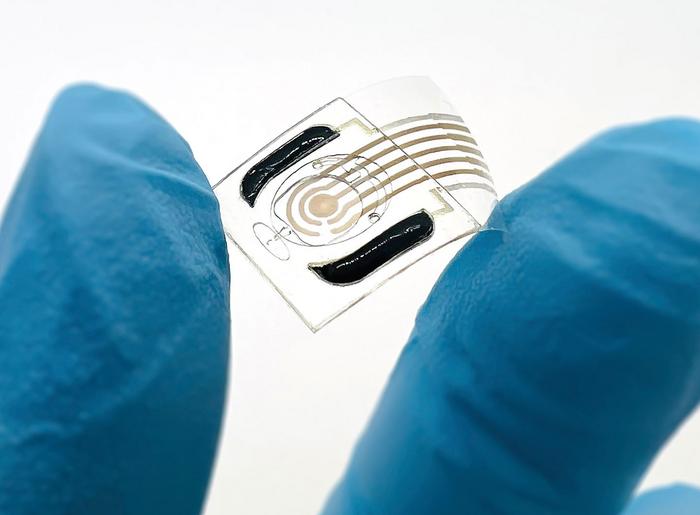
Researchers in the US have developed a wearable sensor that monitors the hormone oestradiol by detecting its presence in sweat.
The team says that the sensor may one day make it easier for women to monitor their oestradiol levels at home and in real time.
The research was conducted by a team at the California Institute of Technology in the lab of Wei Gao, assistant professor of medical engineering, investigator with the Heritage Medical Research Institute, and Ronald and JoAnne Willens Scholar.
In recent years, the researchers has developed sweat sensors that detect cortisol, a hormone associated with stress; the presence of the COVID-19 virus; a biomarker indicating inflammation in the body; and a whole slew of other nutrients and biological compounds.
Gao says the development of the oestradiol sensor was spurred in part by requests from people who were unsatisfied with the options they had for monitoring their oestrogen levels and had seen his previous work.
Gao said: “People often ask me if I could make the same kind of sweat sensor for female hormones, because we know how much those hormones impact women’s health.”
One population of women who would benefit from oestradiol monitoring are those who are attempting to conceive a child, either naturally or through IVF.
The success of either method is dependent on getting timing right with regards to ovulation.
However, not all women have a reproductive cycle that follows a regular schedule.
Some women have been able to track their ovulation by monitoring their body temperature.
But Gao said that method has limited usefulness because it’s not very accurate and body temperature doesn’t increase until ovulation has begun.
The researcher added:
“But oestrogen increases before ovulation.
“With this sweat sensor, we would be able to give people notice ahead of time.”
Other individuals who could benefit from a wearable oestrogen sensor are those undergoing hormone replacement therapy (HRT) because their bodies do not produce sufficient oestradiol.
In these patients, oestradiol levels need to be carefully monitored to ensure they are taking the correct dosage.
The sensor the resarchers developed is similar in many ways to the various sensors developed by the group in the past.
It is built on a flexible plastic membrane; has tiny etched passages (microfluidics) for chanelling small amounts of sweat into the sensor; and inkjet-printed gold nanoparticles and titanium carbide films (known as MXenes) that give the sensor a large surface area and electrical conductivity to increase its sensitivity.
The primary challenge, and what dictated changes in the sensor’s design this time around, is that oestradiol, which already is present at fairly low levels in the blood, is roughly 50 times less concentrated in sweat.
Gao said:
“Since it’s such a low concentration, it’s very challenging to detect oestradiol automatically in sweat.”
For the new sensor, the researchers made use of short single-stranded DNA known as aptamers.
Aptamers work as artificial antibodies that are designed to bind specifically to a target molecule.
The aptamers are attached to a surface modified with gold nanoparticles and bind to single-stranded DNA molecules tagged with a molecule that can directly donate or accept electrons under certain conditions.
When an aptamer binds to an oestradiol molecule, it releases the redox molecule.
That molecule is recaptured by a nearby electrode made of MXene-coated gold nanoparticles, generating an electrical signal that correlates with the oestradiol level.
That hardware then wirelessly transmits the data it collects to an app that runs on a smart phone, providing a simple interface for the user.
A further innovation in this device was the design of the microfluidics that collect sweat and channel it into the sensor.
Tiny automatic valves incorporated in the microfluidics allow only a small, fixed amount of sweat into the sensor and then prevent additional sweat from entering it.
The design enables stable oestradiol analysis without additional sweat disturbing the process.
Also, to account for difference in sweat composition, the device also collects information about sweat pH, sweat salt levels, and skin temperature, and uses them for real-time calibration.
Testing in the laboratory has revealed that the sensor can reliably and accurately track the changing levels of oestradiol in sweat over the course of the reproductive cycle, from the lowest level during menstruation to its highest level (10 times greater) during ovulation.
Gao says he plans to continue working on this technology to allow it to monitor other female hormones, like luteinising hormone or progesterone, which are both involved in ovulation.
He also hopes to miniaturise all these sensors so they could all fit inside of a small wearable device such as an inconspicuous ring that can be worn on the finger.
Image: California Institute of Technology





